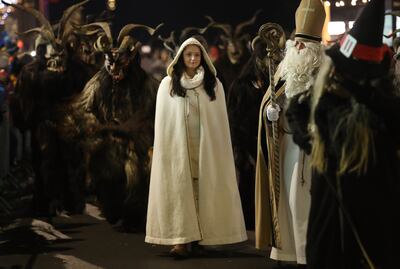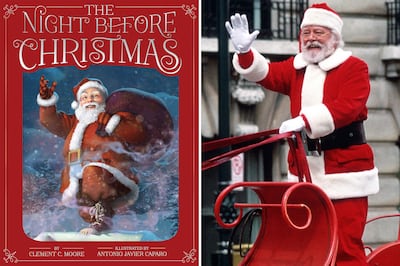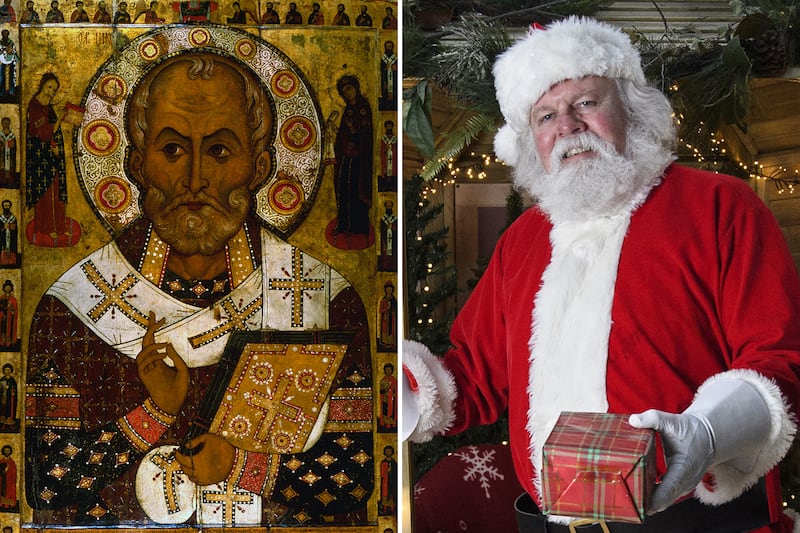The modern version of Father Christmas as we know him today, the jolly, bearded fellow with the red suit, black sack and rounded belly, is the culmination of millennia of folklore, myth, literature and a US Civil War-era cartoonist.
Santa Claus, who goes by different names in different cultures, including Saint Nick, Kris Kringle and Sinterklaas, is based on the real-life Saint Nicholas, the 4th-century Greek Christian bishop of Myra in Lycia of the Roman Empire.
The region is now Demre in modern-day Turkey, where Nicholas is still celebrated today, both as a saint and a symbol of Christmas.
Who was Saint Nicholas?

Saint Nicholas was born into a wealthy Greek Christian family in the city of Patara on the Turkish coast on March 15 in the year 270.
References to him didn’t start appearing until about 200 years after his death on December 6, 343. In the 6th century, Eastern Roman Emperor Theodosius II ordered the building of the Church of Saint Nicholas in Myra (which is still standing) on his burial site.
The traits associated with Santa Claus, such as his generosity, as well as the sack he carries presents around in, can be traced back to early tales about Saint Nicholas. One of the most famous, though unverified, accounts, appears in Michael the Archimandrite's Life of Saint Nicholas biography, written between 814 and 842.
The story goes that in order to save the three young daughters of a man who had lost his fortune, Saint Nicholas visited the house three times, throwing a purse filled with gold coins through the window each time for the father to use as their dowries.
When the father spotted Nicholas on the third night, the saint told him not to tell anyone what he had done, adding the secretive element to the modern version of Father Christmas.
Saint Nicholas in Palestine
Traditionally, the citizens of Beit Jala in Palestine mark Saint Nicholas Day on December 19. Nicholas is the patron saint of the Palestinian-Christian town, which also houses St Nicholas Orthodox Church on the site of the St Nicholas cave where he is said to have lived from 312 to 315; as well as the Greek Orthodox St Nicholas Monastery in Jerusalem, which was built on the site of a home where Nicholas stayed for a year.
He was also named as the patron saint of sailors and travellers when, during a journey to Jerusalem, the ship he was on was almost destroyed by a storm, but Nicholas was said to have calmed the seas.
Becoming Santa Claus
Saint Nicholas is also the patron saint of children, which came about following a story that he had resurrected three children, further cementing his connection to modern Father Christmas.
During the Middle Ages in Europe on the evening of December 5, the day before Saint Nicholas Day, children were often given toys and gifts in his name. The day for giving gifts had moved from the traditional December 24 and 25 owing to the 16th-century Reformation, when the Catholic Church began to oppose the celebration of saints on those dates.
The more modern version of Santa Claus evolved from the Dutch figure of Sinterklaas.
While based on Saint Nicholas, Sinterklaas had his own quirks and traits, such as being depicted wearing a long red cape and holding a shepherd’s staff. He rode a white horse and carried a big, red book in which was recorded which child had been good or naughty in the past year.
He also carried with him a birch rod, which is a chimney sweep's broom made of willow branches. This may have been where the idea of Father Christmas coming down the chimney originated.
Modern Father Christmas

The man in red began appearing in American culture in the 18th century when in December 1773, a newspaper in New York reported on a story about Dutch settlers celebrating St Nicholas Day.
Sinterklaas was anglicised to Santa Claus and in 1804, John Pintard of the New York Historical Society, gave woodcuts of St Nicholas as gifts at the society’s annual meeting. The background of the engraving featured stockings filled with toys and fruit hung over a fireplace.
The character really took hold when celebrated American author Washington Irving, who wrote The Legend of Sleepy Hollow, called St Nicholas the patron saint of New York in his 1809 book, The History of New York.
In 1822, church minister Clement Clarke Moore wrote An Account of a Visit from St Nicholas, also known as ‘Twas The Night Before Christmas as a poem for his daughters, in which he described Santa as “dressed all in fur” with “a bundle of toys he had flung on his back”.
Adding of his physical appearance: “And the beard of his chin was as white as the snow… He had a broad face and a little round belly.”
Moore’s description would serve as inspiration for the political cartoonist Thomas Nast who is credited with creating the first image of modern Santa Claus.
In 1881, he drew a cartoon for Harper’s Weekly which showed a white-bearded and big-bellied Santa holding a sack laden with toys for lucky children. Between 1863 and 1886, he would add the red suit as well as images of reindeer landing on the roofs of houses.





